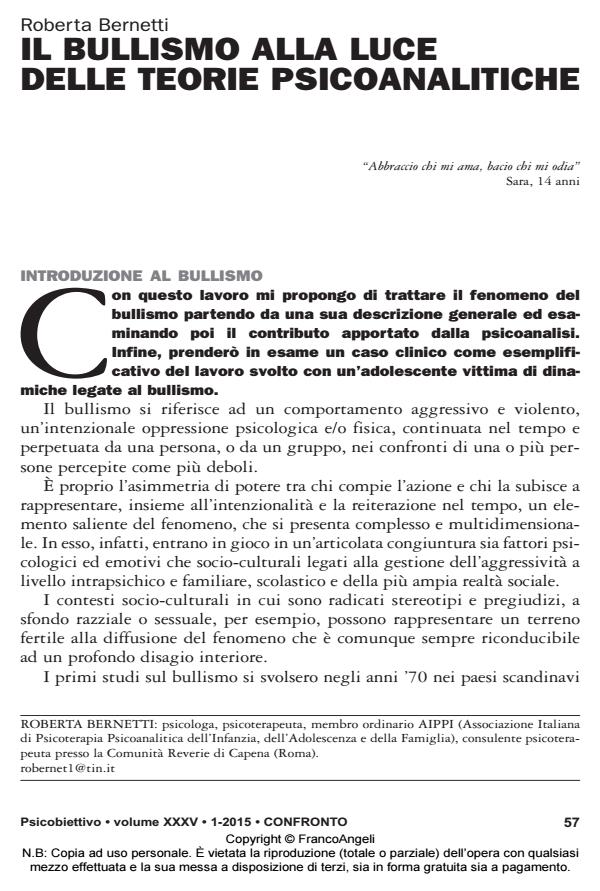Bullying under psychoanalytical theories
Journal title PSICOBIETTIVO
Author/s Roberta Bernetti
Publishing Year 2015 Issue 2015/1
Language Italian Pages 18 P. 57-74 File size 121 KB
DOI 10.3280/PSOB2015-001004
DOI is like a bar code for intellectual property: to have more infomation
click here
Below, you can see the article first page
If you want to buy this article in PDF format, you can do it, following the instructions to buy download credits

FrancoAngeli is member of Publishers International Linking Association, Inc (PILA), a not-for-profit association which run the CrossRef service enabling links to and from online scholarly content.
The author, starting from a general description of bullying, analyses the phenomenon from the psychoanalytic point of view keeping into account the complex overlapping of all factors, which at the psychic and socio-cultural level, enter into account in the treatment of aggressiveness. It is taken into consideration the connection between bulling and group and what differentiate it from gang, which is created by a coalition pact of offence of its members against what is external. The connection between aggression, violence and depression in adolescence is explored and it is also questioned the actual diffusion of bulling not only in adolescence and in pre-adolescence but also in latency. The distinction between a physiological aggressiveness essential for a transit to an adult age and disruptiveness is deepened. It is also taken into account the concept of "dynamics of the internal group" that is a pact of loyalty with an "internal group" which would act a defensive role against the scare of depression: bullying appears as the display of sadism in an internal organization which keeps the subject as a prisoner. The author facuses on therapeutic interventions, which he deems more useful, that is, the psychoanalytic psychotherapy and a scholastic work which is also preventive. A clinical case, at the end, exemplifies the work conducted with an adolescent victim of dynamics correlated to bullying, in an actual social context dominated by idealization of the body and a tendency to violence of the group.
Keywords: Bullying; Aggressiveness; Adolescence; Destructivity; Internal gang; Dependence.
- Bion W. (1961) Esperienze nei gruppi, Armando, Roma, 1961
- Blos P. (1970) L’adolescenza come fase di transizione, Armando, Roma, 1988
- Braconnier A. (2002) “Minaccia depressiva e depressione in adolescenza”, Adolescenza e psicoanalisi, anno II, n. 3,www.psychomedia.it/aep
- Campbell D. (2006) “L’aggressione come difesa contro il breakdown in un adolescente maschio”, Richard e Piggle, 2: 132-146. DOI 10.1711/161.1760
- Carbone Tirelli L. (a cura di) (2006) Pubertà e adolescenza, FrancoAngeli, Roma
- Erikson (1968) Gioventù e crisi d’identità, Armando, Roma, 1974 Freud S. (1909) Osservazione di un caso di nevrosi ossessiva (Caso clinico dell’uomo dei topi), in Opere, vol. 6, Bollati Boringhieri, Torino, 1974
- Freud S. (1938) La scissione dell’Io nel processo di difesa, in Opere, vol. 11, Bollati Boringhieri, Torino, 1979
- Jammet Ph. (1992) Psicopatologia dell’adolescente, Borla, Roma
- Jammet Ph. (1997) “La violenza in adolescenza”, Richard e Piggle, 2: 170-190. DOI: 10.1711/161.176
- Klein M. (1958) “Sullo sviluppo dell’attività psichica”, in Scritti 1921-1958, Bollati Boringhieri, Torino, 1978-202
- Laufer M., Laufer M.E. (1984) Adolescenza e breakdown evolutivo, Boringhieri, Torino, 1986
- Meltzer D. (1979) “Terrore, persecuzione, paura: disamina delle angosce paranoidi”, in Bott Spillius E. (a cura di), Melanie Klein e il suo impatto sulla psicoanalisi oggi, vol. I, Astrolabio, Roma, 1995
- Nicolò A.M., Tabanelli L. (2007) “I mille volti dell’aggressività in adolescenza”, Richard e Piggle, 15, 3: 153-155. DOI 10.1711/305.3621
- Novelletto A. (2000) “Le figure della violenza. Introduzione teorica e stato del problema”, Adolescenza e psicoanalisi, 1, 1. Figure della violenza in adolescenza, gennaio 2001 (Atti del IV Convegno Nazionale di psicoterapia dell’Adolescenza, Alghero, 6-7 ottobre 2000)
- Rosenfeld H. (1971) “A clinical approach to the psychoanalytical theory of the life and death instincts: an investigation into the aggressive aspects of narcisism”, International Journal of Psycho-Analysis, 52: 169-178
- Ruggiero I. (2012) “La cura degli adolescenti borderline: un lavoro sul limite”, Richard e Piggle, 2: 165-180. DOI: 10.1711/1112.1222
- Salzberger-Wittemberg I., Williams Polacco G., Osborne E. (1993) L’esperienza emotiva nel processo di insegnamento e di apprendimento, Liguori, Napoli
- Steiner J. (1993) I rifugi della mente, Bollati Boringhieri, Torino, 1996
- Waddell M. (2000) Mondi interni, Bruno Mondadori, Milano
- Handbook of Research on Applying Emerging Technologies Across Multiple Disciplines Raffaele De Luca Picione, Elvira Martini, Fabrizio Corona, Maria Libera Falzarano, Sara Cicchella, pp.352 (ISBN:9781799884767)
Roberta Bernetti, Il bullismo alla luce delle teorie psicoanalitiche in "PSICOBIETTIVO" 1/2015, pp 57-74, DOI: 10.3280/PSOB2015-001004